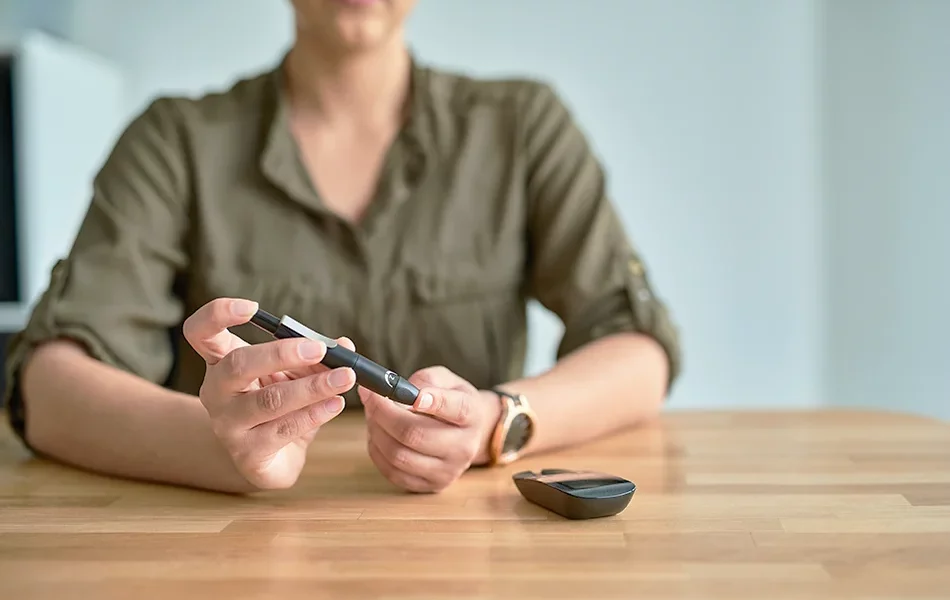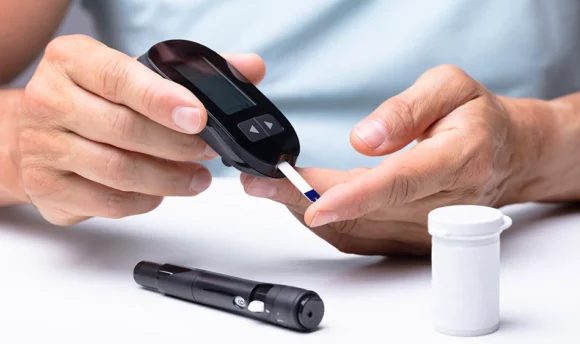Ketosis and Optimal Blood Sugar Level: Why You Should Monitor It and How
Whether you’re looking to lose weight, manage type 2 diabetes, or improve your general well-being, understanding your optimal blood sugar level for ketosis is essential.

Find out why this is and how you can monitor it whilst on the ketogenic diet.
Monitoring your blood sugar levels is an important way to measure your success on the ketogenic diet.
Letting these levels increase too frequently means that you will be unable to experience the benefits of the keto diet and may struggle to lose weight. It is, therefore, important to understand how to monitor blood sugar and keep it at the optimal level for ketosis.
Read on to discover what ketosis is, the reasons why you should keep track of your blood sugar levels, and how you can most effectively do this.
Blood Sugar Level for Ketosis: What You Need to Know
Blood sugar level tracking is a tool that is frequently utilized as an indicator of good overall health and is particularly popular with those on the ketogenic diet.
This is because the goal of those on keto is to remain on a low-carbohydrate diet whilst increasing fat consumption, which in turn keeps blood sugar levels relatively low.
Lower blood sugar is essential for ensuring that the body is in ketosis, which is the goal for those aiming to lose weight through keto.
In contrast, if you are on the keto diet and find that your blood sugar levels are increasing, this indicates that you are no longer in ketosis.
You may, therefore, not be losing weight or experiencing any of the other benefits of ketosis, such as lower blood pressure or reduced risk of heart disease.
What Are Optimal Blood Glucose Levels for Ketosis?
Optimal blood glucose levels are likely to vary from person to person. However, on average, the optimal fasting blood sugar level is between 70–90 mg/DL.
Anything lower than 70 mg/dL is classed as low blood sugar and may indicate hypoglycemia. This can cause you to feel lightheaded, nauseous, and confused.
If this occurs, you should seek immediate medical attention, as hypoglycemia can lead to complications such as seizures and, eventually, death.
Those on the ketogenic diet should aim to keep their levels of blood glucose as stable as possible so that they can remain in ketosis.
Your blood glucose levels should, therefore, be measured periodically throughout the day to ensure that they remain at an optimal level.
You can do this by conducting a finger-prick test or by using an electronic tool, such as a continuous glucose monitor (CGM).
For instance, you should check your blood glucose level first thing in the morning before breakfast, as you will not have consumed any food for 7–9 hours.
You should also monitor the level both immediately before and after eating so that you can ensure that it does not become too elevated for ketosis.
Another way of achieving optimal blood glucose levels for ketosis is to test at the same time each day. This will ensure that you get consistent results that will tell you if you are staying in ketosis from day to day.
What Is Ketosis?
Ketosis is a temporary metabolic state that the body enters when it begins burning stored fat rather than glucose, or blood sugar, as its main energy source.
Most people who lower their carbohydrate intake to less than 50 grams per day will enter ketosis within days. However, this can take over a week, depending on factors such as age, fitness levels, and whether you have a fast or slow metabolism.
For those consuming a regular balanced diet, the body typically breaks carbohydrates down into glucose to use as fuel. The unused glucose is then stored in the liver and released as and when it is needed for energy.
However, if you are on the keto diet, you will only be getting 5–10% of your daily calories from carbs. As your carb intake is so low, you will not have enough stored glucose for the body to use as energy.
Instead, the body begins to break down fat into ketones, a chemical produced by the liver that becomes the body and brain’s main energy source.
When in ketosis, your body will also produce ketones from the high levels of keto-friendly healthy fats that you are consuming, which make up approximately 70–80% of your total daily calories.
As blood glucose levels in your body decrease, your pancreas will detect this change and begin to secrete less insulin, which is the hormone responsible for blood sugar control within the body.
In response, your liver will begin to increase its ketone production so that there is enough energy available for your body and brain to continue functioning.
This means that when you are in ketosis, your blood ketone levels will be high. Therefore, if you have a large number of ketones in your blood, your blood glucose levels should be relatively low.
How to Measure Blood Sugar During Ketosis
Monitoring blood sugar effectively involves using a glucose meter. There are several types of glucose meters, from traditional finger-prick devices to the more advanced continuous glucose monitors (CGMs).
To discover what your blood sugar level is in real time, you could use a traditional finger-prick test. This involves using a sharp needle known as a lancet to draw blood from your finger before using a test strip and meter to take a reading.
Alternatively, you may choose to use a CGM, which allows you to monitor your glucose levels throughout the day.
This is typically a small device that can be worn on your body, which connects to a glucose monitoring or diabetes management app that notifies you when glucose levels change.
Readings can then be checked throughout the day, both before and after meals, to ensure that your normal and fasting blood sugar levels are optimal for ketosis. You will also be able to see your average blood sugar level for the day.
Monitoring Keto Blood Sugar Levels for Type 2 Diabetes
In addition to those looking to lose weight, people with type 2 diabetes can benefit from tracking their blood sugar levels.
Research has found that CGM is an empowering tool for patients with diabetes. CGM allows them to access data on their blood sugar levels effortlessly and take action to prevent hypo or hyperglycemia.
High blood sugar levels can be an indicator of insulin resistance, which occurs when cells within the liver, fat, and muscles develop an insulin sensitivity and respond poorly to its production.
Insulin is a key hormone in regulating blood sugar levels within the body, as it helps blood glucose to enter the cells for energy. It also signals when the liver should begin storing glucose for later use.
However, rather than being utilized by the cells, insulin resistance leaves high levels of glucose in the blood. This is a condition known as hyperglycemia, which can lead to the development of type 2 diabetes over time.
There is an increasing prevalence of diabetes in the US, with an estimated 11.3% of the population having the disease and 38% having pre-diabetes.
Following the ketogenic diet lowers the risk of developing conditions such as diabetes, as it allows you to monitor when your blood glucose levels are rising.
Keto also helps those with type 2 diabetes to manage the condition, as most keto-friendly foods also make the list of diabetes-safe foods.
This is because choosing low-carb options reduces blood sugar spikes that are harder to control due to insulin resistance.
FAQs
Ketosis generally begins at a low blood sugar level of 70 mg/dL. However, this can vary from person to person, depending on factors such as how long they’ve been on the keto diet and their overall health.
This means that it can be difficult to figure out normal blood sugar levels for ketosis, and you should, therefore, look out for some other early ketosis signs.
In general, blood sugar levels above 90 mg/dL are outside the optimal range, which means you may have difficulty maintaining ketosis.
Consistently high blood glucose levels also put you at greater risk of developing diabetes.
Many glucose meters enable users to monitor their glucose ketone index (GKI), which indicates their level of ketosis.
Measuring your ketone levels while on the ketogenic diet is important to ensure that you stay in ketosis. For example, to be in nutritional ketosis, your GKI should be between 0.5–3 mmol/L.
A Word From an MD
There are several benefits of nutritional ketosis, which include aiding weight management, increasing satiety after eating, and lowering blood pressure.
Measuring blood glucose is a highly effective method for ensuring that you remain in the ketosis phase consistently. This is because it allows you to monitor your daily carb intake and the effects that ketosis may have on your body.
If your glucose meter indicates that your blood sugar levels are unbalanced, then you should put measures into place to ensure that they remain at an optimal level.
For example, this may include selecting sources of protein and healthy fats when filling your plate to provide energy and keep you fuller for longer.
Consuming plenty of fiber through foods such as chia seeds and avocado is another great way of promoting blood sugar control. Dietary fiber is also crucial for ensuring that your blood sugar levels don’t drop drastically.
Conclusion
Whether you are trying to lose weight or manage type 2 diabetes, you should monitor your blood sugar levels to fully experience the benefits of the keto diet.
You can do this using a glucose meter and taking frequent readings throughout the day. This will indicate if you are in ketosis or if your sugar levels are too high.
To ensure that you are in optimal ketosis, tracking your blood sugar and ketone levels should go hand in hand. Your optimal blood sugar level for ketosis should, therefore, be 70–90 mg/dL, with a ketone level between 0.5–3mmol/L.

















































 Select your language:
Select your language: 








